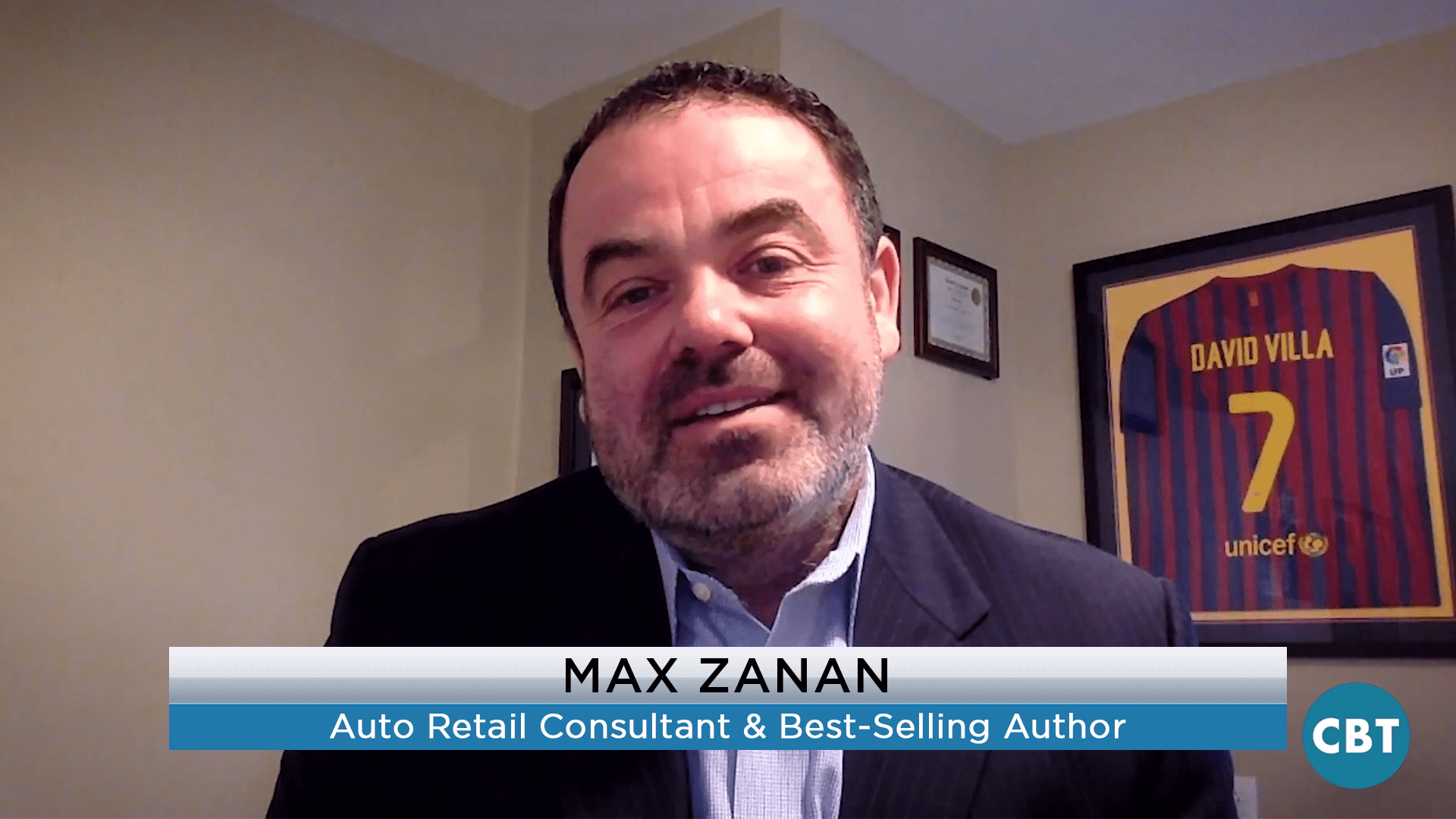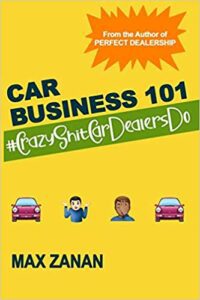On today’s show, we welcome back Max Zanan, automotive retail consultant, and best-selling author of “Perfect Dealership” and “Car Business 101”. In this segment, Max and Jim discuss how to accurately assess your dealership’s strengths and weaknesses.
Jim Fitzpatrick: Max Zanan, we’d like to welcome you back to CBT News. So glad you could take the time out of your day to join us today.
Max Zanan: Thank you for having me.
Jim Fitzpatrick: Sure. So, I understand you have a new book out. Tell us all about it. ‘Car Business 101’.
Max Zanan: So, as you know, I wrote another book over a year ago. It’s ‘Perfect Dealership’. That book was more of a textbook. So, I dedicated each chapter to a particular department. So, because we suffer from lack of professional education in automotive retail. There’s no F&I major at your local university or Fixed Ops major.
Jim Fitzpatrick: Heck no. No, there isn’t.
Max Zanan: So, I did it to make sure that viewers have something to look at and use as a point of reference. The second book I wrote is called ‘Car Business 101’ and it’s the opposite. It’s the flip side of perfect dealership. So, as you know, I’m in dealerships every single day. So, I see it with my own eyes. What I did is, I actually listed the things that make no sense. I’ll just give you a few examples. For example- Some dealers wholesale off-brand cars. Go figure. Why would you do that? Or dealers refuse to mystery shop their own businesses.
Jim Fitzpatrick: That’s right. That’s right.
Max Zanan: Not understand … Majority of dealer principals do not understand service and parts. And completely stay away from those departments.
Jim Fitzpatrick: Well, as you know, a lot of people that are running dealerships today came out of the variable ops side of the industry and have said, “Look, I’ve got a good fixed ops director. He or she knows what they’re doing. I don’t want to get in their way. They probably know a lot more about that side of the business than I do.”
Therefore, in large part they don’t typically, and I know I’m painting with a broad brush here, but they don’t typically become a student of that. I can speak from my own experience in that area, in that, when I was a GM and a dealer principal and such, I really didn’t take the time necessary to understand fixed ops at a much higher level.
That was a mistake I made. I think it’s … I think I probably share that with a lot of other baby boomer dealers out there that just say, “Hey, I came out of sales. I was a sales manager, GSM, GM, dealer principal, and ran with it and didn’t spend a lot of time in the service department.”
Max Zanan: I heard a fascinating statistic at NADA, that 97% of GMs, dealer principals, and partners, came out from variable operation.
Jim Fitzpatrick: Yeah. Makes sense.
Max Zanan: So, again, in the past, you could make money selling cars and it was okay not getting involved with fixed ops. But, I think now, because of the margin compression- it is an absolute must for the dealer principal and general manager- to spend and understand fixed ops, because that’s where the money is and that’s where their money is going to be.
Jim Fitzpatrick: So, cover some of these other things in the book.
Max Zanan: Not seeing the danger of OEM subscriptions. A lot of dealers completely dismiss it. Meanwhile, if you speak to Volvo retailers, they’re ready to pull their hair out.
Jim Fitzpatrick: Well why? Over what?
Max Zanan: Well, think of it this way. Let’s say you have a Volvo dealership and Volvo has a subscription model. Whereas now, you have to compete, not with another Volvo dealers, but with your own factory. This is the factory that’s telling you to spend x amount of millions of dollars on facility upgrades. That’s the same factory that will be holding the allocation to make sure they have enough cars for their subscription customers.
Jim Fitzpatrick: Oh, yeah. That’s a good point.
Max Zanan: Yeah, you know. Outside of Volvo, I don’t see other retailers are really being concerned. Because don’t forget, BMW is piloting, Mercedes is piloting. Everybody wants to, slowly but surely, get into subscriptions. My fear is that it’s an opening for the OEMs to break the franchise worlds. Especially in light of Tesla going online- with their sales efforts. I’m pretty sure other OEMs are watching it very closely. If Tesla is successful, they will probably make an attempt to replicate it.
Jim Fitzpatrick: There seems to be some mixed reviews on the whole subscription topic. People … It seems as though some OEMs tried it, didn’t do too well with it, and kind of dialed it back.
Max Zanan: That’s Cadillac.
Jim Fitzpatrick: Yeah. Cadillac.
Max Zanan: But, allegedly Cadillac is coming back with the revamped version of their subscription model in a few months.
Jim Fitzpatrick: Oh. That’s a different story. Okay.
Max Zanan: Again, I think dealers … Subscription is not going to replace traditional buying or leasing. But, dealers are so much better equipped to actually do this then OEMs. Especially if you have multiple rooftops. Why can’t you have your own subscription model?
Jim Fitzpatrick: Well, we’re coming off of another, what many experts are looking at and saying we’re in a little bit of a slump in the retail automotive sales here and we’re coming off of another tough month to finish the quarter, the first quarter of 2019. So, I think you’re going to see dealers looking for alternative ways to remove the iron, right? And to make money. This may be one of them.
Max Zanan: Well, my honest opinion is that all these experts are almost talking everybody into a recession. I mean, look at the fundamentals of our economy. It’s the lowest unemployment. The consumer confidence is pretty high, even though interest rates went up a little bit. They’re still historically low. So, if we’re worried about selling cars in this environment, what are we going to do when an actual recession will take place?
Jim Fitzpatrick: That’s right. Dealer’s will get comfortable with selling 16.8, 17 million, 17.2 million vehicles and kind of let things go here and there because the success is pouring in the front door. Right?
Max Zanan: I think a lot of dealer principals suffer from amnesia. Right? It’s like 2008 never happened. So, all they have to do is take out a financial statement from 10 years ago. Put it side by side with their last financial statement. They will see the amount of fat that they acquired over the last 10 years.
Jim Fitzpatrick: Oh, yeah. For sure.
Max Zanan: Because there are two ways to make money, right? You either sell more cars or you cut expenses. There’s plenty of expenses to be cut in today’s environment. If you were a dealer today, what areas would you focus on in this current economy that we’re in, in the retail automotive sector? The first thing I would do, I would relocate my office to the service department.
Jim Fitzpatrick: Really?
Max Zanan: Yes. I would spend all the time in the service department. Let’s look at the margins.
Jim Fitzpatrick: Of course, to some of the dealers that are listening right now, Max, they say, “That sounds good. But, you don’t have a service customer until you sell them a new car or a used car.”
Max Zanan: I mean, when we sell 16.8 million cars, you’re bound to sell some cars, even if you’re not trying, you know? So, you have to, now, continue and service that customer. To be honest with you, in many cases, you don’t even have to sell them a car. What happens to all the units in operation in your zip code?
Then, the reason I would relocate my office there, is to physically be there, just to see what happens because when customers come in and they don’t get treated right, they’re never coming back. Listen, you don’t have to focus on efficiency and proficiency. You first need to understand the basics of customer service.
There needs to be eye contact. They need to know who they’re going to see, where they’re going. If we provide loaners. If we can put them in an Uber and send them to work. If we communicate the updates of the repair. By text message, because these are the basics that you have to master first.
The second thing I would do, I would start focusing on retailing parts online. Because you have to expand your primary market. What’s stopping you from selling these parts online through Amazon? Unfortunately, nobody’s doing it.
Jim Fitzpatrick: Why?
Max Zanan: A tiny, tiny … Because it requires work. Why do you need to put in effort when we clock in 17 million sales?
Jim Fitzpatrick: So, you’re saying dealers better really watch out now because it may get tougher here in the future, right?
Max Zanan: It will get tougher because … Listen, the economy is cyclical. At some point it will get tougher. But, even if it doesn’t get tougher, just look at the margins, right? It’s virtually impossible to make money selling cars. However, we still average 40 to 50% markup on parts, 75% markup on labor.
Jim Fitzpatrick: That’s a good point.
Max Zanan: I mean, amazing margins.
Jim Fitzpatrick: That’s right. That’s a very good point. That’s where dealers need to focus their energies.
Max Zanan: I will give you a personal example. I bought a car a couple of weeks ago and later I realized that I needed all weather mats. So, I figured I’m going to go to the dealer’s website and just order them online. I couldn’t do that. Then, I went to his competitor and another competitor. I’m in New York City. I ended up buying those floor mats from a dealership in Massachusetts. That’s the only dealer who figured out how to retail floor mats online.
Jim Fitzpatrick: Right. They were … Now-
Max Zanan: So, the message is, for dealers that are panicking or worried about online sales, I mean, they need to really crawl before they walk and master part sales online before they even think about retailing cars online.
Jim Fitzpatrick: Well, Max Zanan, Automotive Retail Consultant and author of two great books, ‘The Perfect Dealership’ and now, ‘Car Business 101’. Thank you so much for joining us on CBT News. It’s always very enlightening and, at times, entertaining. We appreciate all of your input here today. Hopefully, we can have you back and go through some of these other things in your new book.
Max Zanan: Excellent. Thank you so much.
Jim Fitzpatrick: Thanks for joining us.
Max Zanan: Take care.
Thank you for watching the official news source of the Retail Automotive Industry. This has been a JBF Business Media production.









